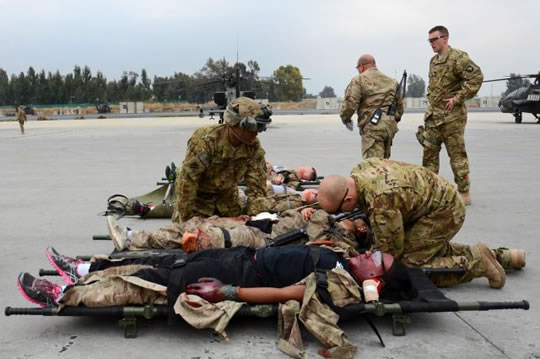PALO ALTO, CA – Hacking isn’t always a bad thing, especially if the result is devices that can help protect servicemembers from injuries.
A project called Hacking for Defense (H4D) started as a pilot 10-week class at Stanford University in 2016. Steve Blank, creator of the Lean Startup movement, and retired Army Cols. Peter Newell and Joe Felter developed the concept for H4D. In the program, students are urged to think out the box.
“We combined the Lean Startup methodology — used by the National Science Foundation to commercialize science — with the rapid problem sourcing and solution methodology Pete developed on the battlefields in Afghanistan and Iraq when he ran the U.S. Army’s Rapid Equipping Force,” explained Blank in a commentary he wrote July 19.

Warfighters from the 129th Rescue Wing demonstrate casualty triage to students from a Hacking for Defense class at Stanford University. The students were part of a team, sponsored by the U.S. Army Medical Materiel Agency, to evaluate methods to reduce bottlenecks in casualty care triage using novel technology — specifically, wearable sensors. (Photo Credit: U.S. Army photo )
A year after its launch, H4D now is at nine universities nationwide, including Stanford University, Georgetown University, University of Pittsburgh, Boise State, University of California San Diego, James Madison University, University of Southern Mississippi, University of Southern California and Columbia University.
As part of H4D, “sponsors” from inside the DoD and intelligence community participate to help students better understand the problems they are facing.
“We believed if we could get teams to rapidly discover the real problems in the field using Lean methods, and only then articulate the requirements to solve them, then defense acquisition programs could operate at speed and urgency and deliver timely and needed solutions,” Blank said.
That’s what occurred with one recent sponsor, Maj. Amanda Love, a nurse consultant at the U.S. Army Medical Materiel Agency and member of the defense acquisition community. At USAMMA, Love is a project manager who works with a team responsible for the full lifecycle of U.S. Food and Drug Administration-approved patient care devices.
“Lifecycle management of complex medical materiel, such as patient care devices, is not a simple process. Every part of the process is interconnected, from development of new products to full procurement, fielding and sustainment,” Love explained. “Every new technology we develop and field must be well-planned and supported at multiple levels.”
Love’s H4D team, one of eight teams participating in this session of H4D at Stanford University, included two software engineers, one programmer and one medical student, The team was asked to find ways to speed casualty care triage using novel technology, most notably wearable sensors.

Warfighters from the 129th Rescue Wing demonstrate casualty triage to students from a Hacking for Defense class at Stanford University. The students were part of a team, sponsored by the U.S. Army Medical Materiel Agency, to evaluate methods to reduce bottlenecks in casualty care triage using novel technology — specifically, wearable sensors. (Photo Credit: U.S. Army photo )
“When the team started to develop their concepts for using wearable devices, it was a sort of ‘wow’ moment for me. As a clinician, I am familiar with using wearable sensors to monitor vital signs. But this is something we currently do in a hospital setting — not at the point of injury,” Love recounted.
The group, called “Team Surgency,” interviewed more than 90 experts, including trauma doctors, military medics, combatant commandeers and Special Forces personnel, as well as those in industry and academia. industry and academic. The studies also toured military installations to learn more about casualty triage and what might help provide better care for wounded warriors.

